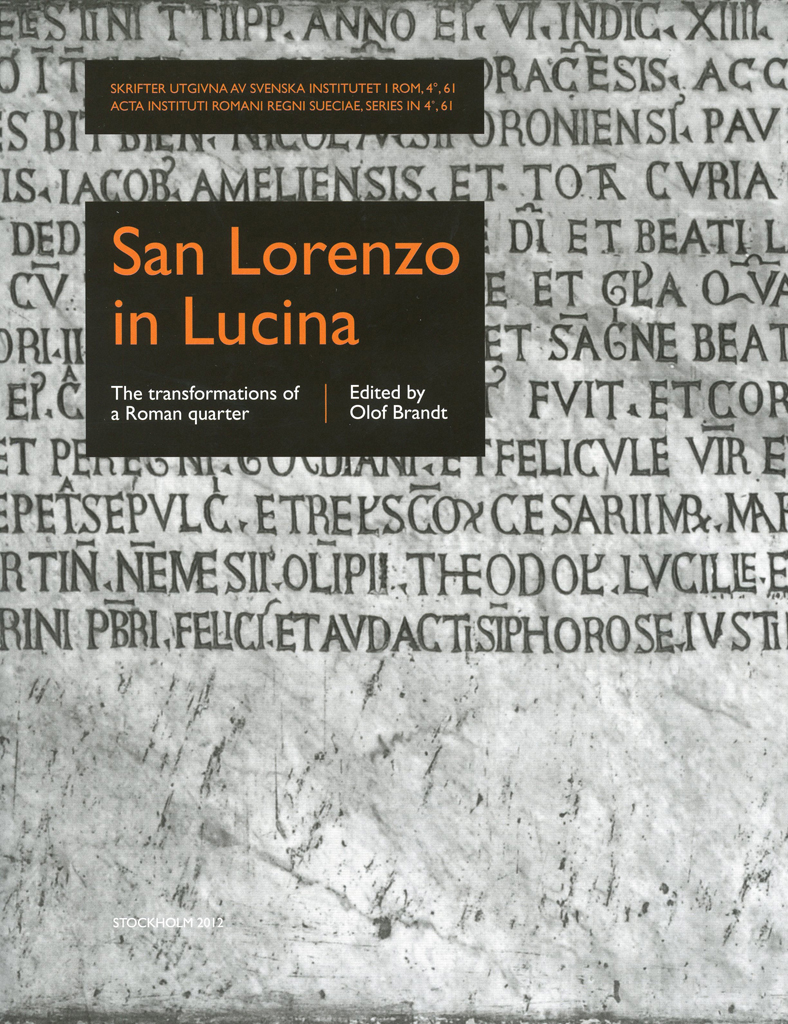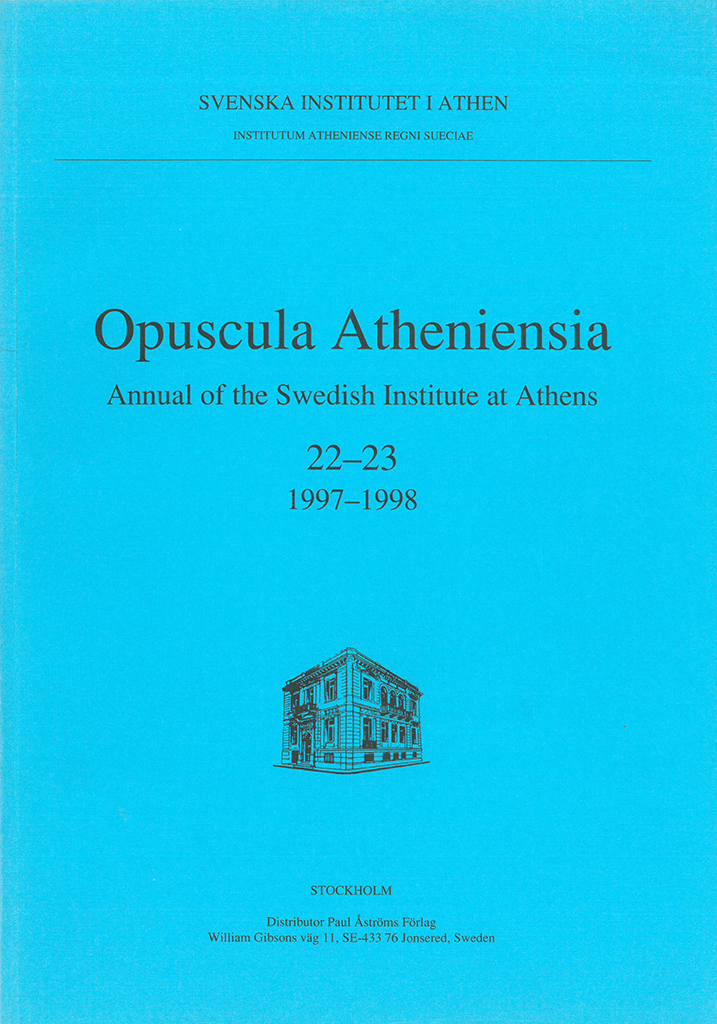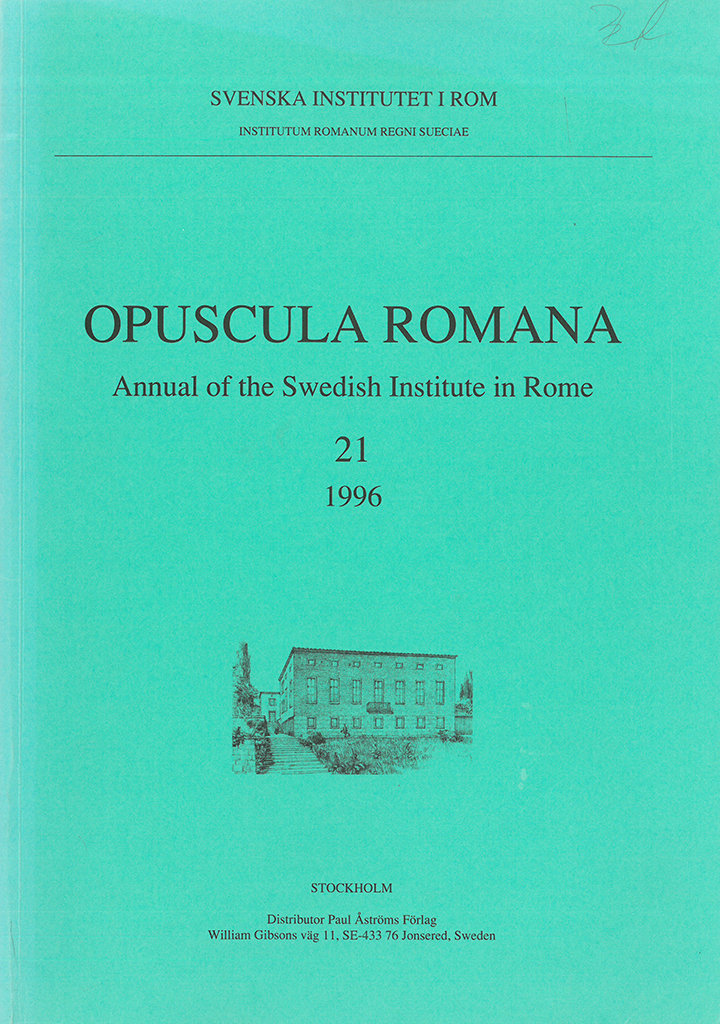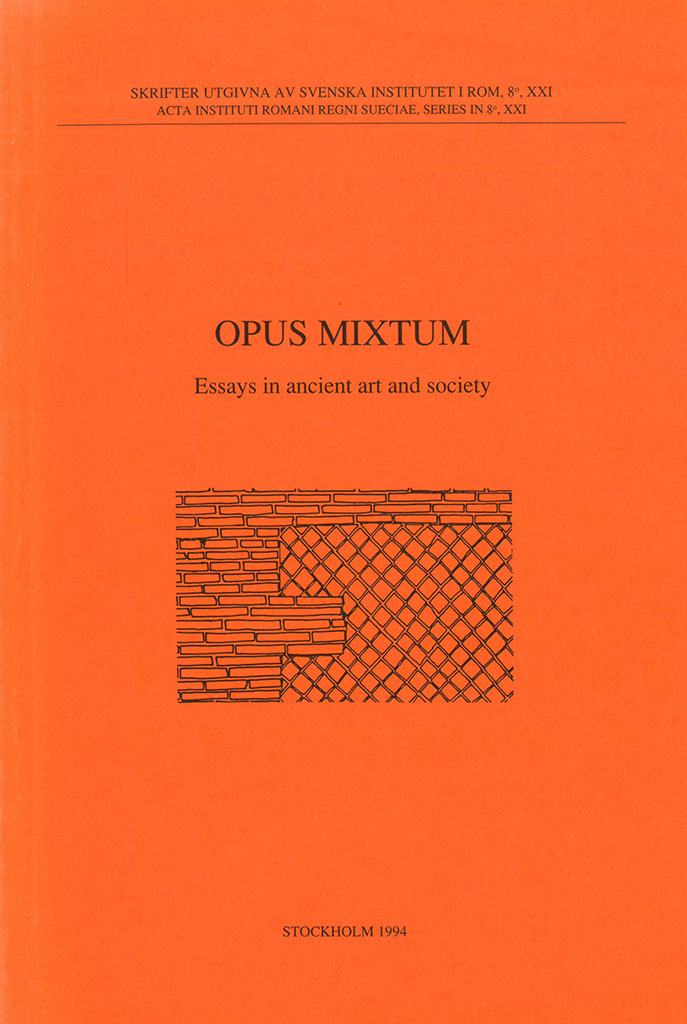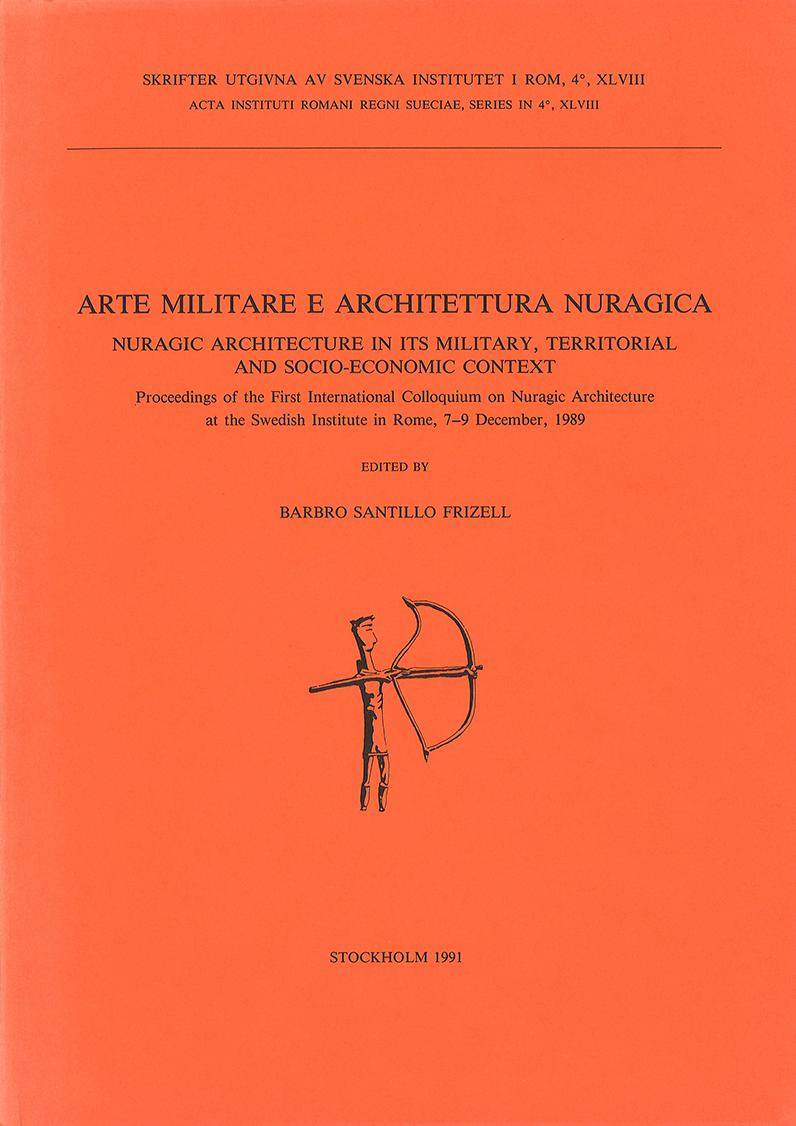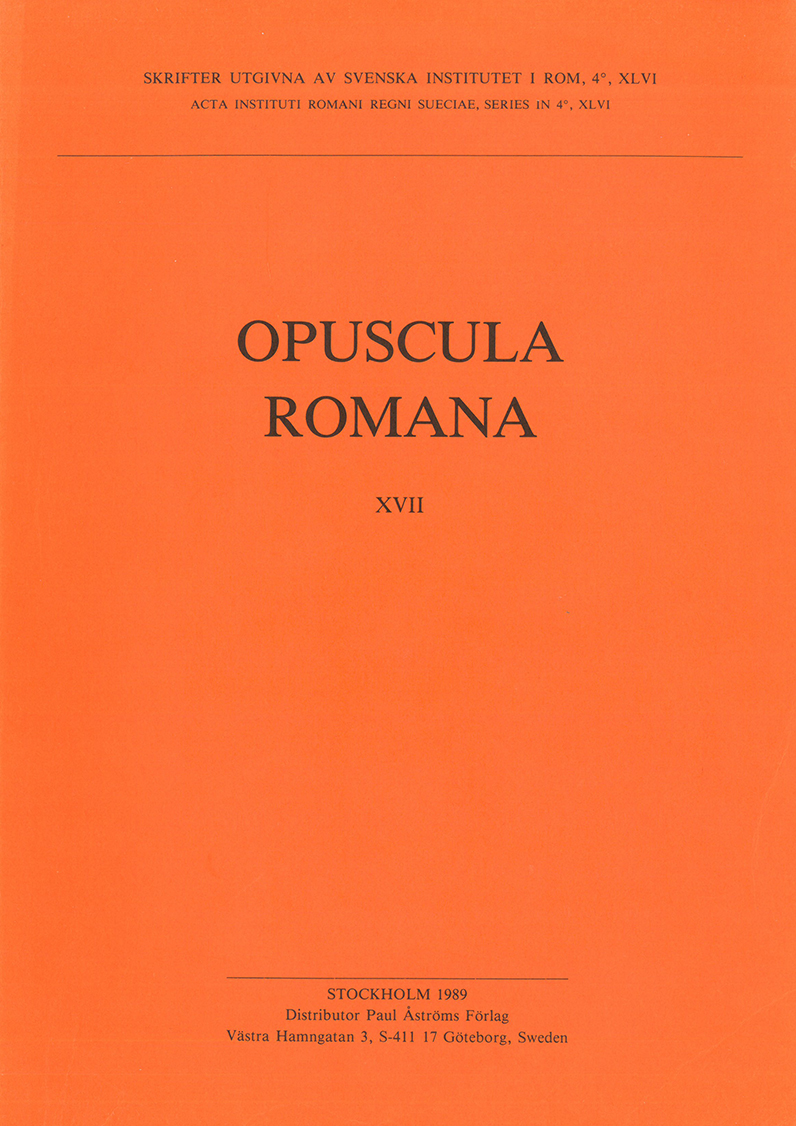Distributed by Eddy.se AB. Also available at Amazon.com, Amazon.de, Bokus.com, and Adlibris.com. San Lorenzo in Lucina. The transformations of a Roman quarter By Olof Brandt (ed.) This volume presents the results of research carried out by the Swedish Institute in Rome in the Roman church of San Lorenzo in Lucina. This research involved the Roman phases of the site and the surrounding quarter. The research began with the 1993–1998 excavation of the baptistery of the Early Christian church, and continued in 2000 with a project which also included other parts, aspects and periods of the site. The papers in this volume shed new light on the Late Roman and post-Antique development of an area which is between Augustan monuments such as the Ara Pacis, the Mausoleum of Augustus, the obelisk and its meridian. The papers include studies on the early 3rd century insula beneath the church, the baptistery and the Early Christian basilica, as well a survey of hagiographic legends, medieval wall-paintings, and other finds such as inscriptions and graffiti, pottery, glass, marble, bones and spolia. Reports on the conservation on fragments of Roman wall-paintings and marble fragments are also included. Contents Barbro Santillo Frizell | Preface Olof Brandt |…
Distributed by Eddy.se AB. Available for purchase at Amazon.com, Amazon.de, Bokus.com, and Adlibris.com Via Tiburtina. Space, movement and artefacts in the urban landscape By Hans Bjur & Barbro Santillo Frizell (eds.) How can cities integrate historic layers into their urban development? How can tangible and intangible heritages be read, interpreted and utilised in a sustainable city and landscape development? What significance could an ancient road have in this context? These are the overall questions in this book. It contains a number of different approaches to the interaction between the ancient road Via Tiburtina and the surrounding urban landscape east of Rome towards Tivoli, a rich palimpsest of distinguishable interrelated layers created over at least three millennia. One hypothesis being explored is that structures like Via Tiburtina still can determine the morphology of the urban landscape. Settlements, buildings, space, movement and cultural artefacts have therefore come into focus in investigating whether broken connections could be re-established, and thus creating a dialogue between Rome’s earlier epochs and the future. Contents Index map Introduction Hans Bjur & Barbro Santillo Frizell | Ways to urban landscape archaeology Hans Bjur | That’s the way it is Movement Barbro Santillo Frizell | Changing pastures Simon Malmberg…
Distributed by Astrom Editions. Contents Marie-Françoise Billot | Sanctuaire et cultes d’Athéna à Argos (pp. 7–52) Hélène Borrman, Mascot Fjaestad-Seger, E. Urban Engström & Paul Åström | A dental radiographic examination of a Late Bronze Age skull from Kition (pp. 53–56) Katie Demakopoulou, Nicoletta Divari-Valakou, Paul Åström & Gisela Walberg | Excavations in Midea 1995–1996 (pp. 57–90) Johan Flemberg | An Anadyomene in the Milles Collection (pp. 91–101) Barbro Santillo Frizell | Monumental building at Mycenae. Its function and audience (pp. 103–116) Jane F. Lloyd | The Minoan hall system and the problem of an entrance to the South House at Knossos (pp. 117–140) G.H.R. Wright | Puer aeternus in prehistoric Cyprus (pp. 141–146) Miscellanea Göran Henriksson & Mary Blomberg | Petsophas and the summer solstice (pp. 147–151) Penelope A. Mountjoy | An octopus stirrup jar from Kalymnos (pp. 152–154) In memoriam Alfred Westholm (written by Paul Åström) (p. 155) Erik Holmberg (written by Paul Åström) (p. 156) Book reviews Henrik Gerding | P. James et al., Centuries of darkness. A challenge to the conventional chronology of Old World archaeology (pp. 157–160) Gunnel Ekroth | C.M. Antonaccio, An archaeology of ancestors. Tomb cult and hero cult in early Greece (pp….
Published by the Swedish Institute of Classical Studies in Rome. Distributed by Astrom Editions. Contents Gabriella Barbieri, Le necropolis etrusco-romane di Poggio Giudio e Casale Merlani presso Viterbo (pp. 7–51) Peter Danner, Bikonische Gefässe aus Chiusi (pp. 53–56) Barbro Santillo Frizell, Per Itinera Callium. Report on a pilot project (pp. 57–81) Lars Karlsson, The altar of Hieron at Syracuse. A discussion of its function (pp. 83–87) Allan Klynne & Peter Liljenstolpe, The Villa of Livia at Prima Porta. A report on the excavation of room 45 (pp. 89–100) Peter Liljenstolpe, An Ionic capital from the Villa of Livia at Prima Porta (pp. 101–105) Margareta Strandberg Olofsson, Celebration or death? Aspects of a new amphora from the Micali Painter’s workshop and the iconography of Etruscan black-figured vases (pp. 107–118) Örjan Wikander, Senators and equites VII. Matrilinear relationships and cognate nomenclature in the Roman Republic (pp. 119–124) Book reviews Allan Klynne, review of T.J. Cornell, The beginnings of Rome. Italy and Rome from the Bronze Age to the Punic Wars (c. 1000–264 BC) (pp. 125–129) Örjan Wikander, review of S.B. Downey, Architectural terracottas from the Regia (pp. 129–131) Örjan Wikander, review of D. Castella et al., Le moulin hydraulique gallo-romain d’Avenches “En…
Distributed by Astrom Editions. Opus Mixtum. Essays in ancient art and society Edited by Eva Rystedt, Charlotte Scheffer, and Charlotte Wikander Fifteen papers on various aspects of ancient art and society are gathered in this volume. They deal with the choice of moment depicted in the Parthenon frieze, the use of the Greek architectural orders in political propaganda, and the “programme” of the relief plaques from zone F at Acquarossa which is suggested to be celebrations connected to the ruler. The architectural layout of a well-temple in Sardinia is interpreted as an iconographic message of the cult of Tanit-Astarte. The significance of the horse in connection with death and the various types of female deities connected with horses in Archaic Greek religion are discussed, as well as the image of Artemis Ephesia and its connection with the mysteries of the goddess, the epithet Ambologera (“Delayer of old age”) attributed to Aphrodite, and the role of women in Roman religion. A white-ground lekythos by the Achilles Painter with the “mistress-and-maid” motif associated with music-making is analysed. A reconstruction of the Laocoon group, especially regarding the positions of the serpents is put forward. A marble head of Dionysos in the Swedish Zorn…
Published by the Swedish Institute of Classical Studies in Rome. Distributed by Astrom Editions. Arte militare e architettura nuragica. Nuragic architecture in its military, territorial and socio-economic context. Proceedings of the First International Colloquium on Nuragic Architecture at the Swedish Institute in Rome, 7–9 December, 1989 Edited by Barbro Santillo Frizell Twelve papers given at the first international colloquium on the function of the Sardinian nuraghi held at the Swedish Institute in Rome dealing with, in particular, the military function of the nuraghi in relation to tactics and strategy, their territorial distribution and spatial patterning; models for the interpretations of the social and economic development in nuragic society; the social significance of the nuraghi; and the art of warfare from the evidence of related finds. Contents Barbro Santillo Frizell, ‘Introduzione’, 7–12 Barbro Santillo Frizell, ‘Introduction’, 13–18 Miriam Balmuth, ‘Nuragic camouflage’, 19–22 Paola Basoli & Alba Foschi Nieddu, ‘Il sistema insediativo nuragico nel Monte Acuto: analisi preliminare dei fattori geomorfologici e socio-economici’, 23–40 Lucia Manca Demurtas & Sebastiano Demurtas, ‘Analisi dei protonuraghi nella Sardegna centro-occidentale’, 41–52 Stephen L. Dyson & Robert J. Rowland Jr, ‘Continuity and change in Roman rural Sardinia: The Maryland-Wesleyan survey’, 53–63 Leonore Gallini, ‘Architectural evidence for the…
Distributed by Astrom Editions. Opuscula Romana 17 Contents Johnny Bengtsson, ‘Survey in Italy, “La Farnesina project”’, pp. 7–8 Mats Cullhed, ‘Maxentius as princeps‘, pp. 9–19 Ingrid Edlund-Berry, ‘Four terracotta heads from Poggio Civitate (Murlo). Towards a definition of the ‘Murlo style’’, pp. 21–32 Gloria Ferrari, ‘Felicior Augusto—portrait medallions in glass and the Ravenna relief’, pp. 33–60 Erik Holmberg, ‘Who made the vases of the Red-Line Painter and relations?’, pp. 61–76 Lars Karlsson, ‘Some notes on the fortifications of Greek Sicily’, pp. 77–89 Giordano Labud, ‘Il territorio del sito archeologico di San Simone d’Isola’, pp. 91–95 Kyle M. Phillips, Jr. (†), ‘Notes from Berlin on a bronze owl’, pp. 97–122 Stefania Quilici Gigli, ‘Paesaggi storici dell’agro falisco: i prata di Corchiano’, pp. 123–134 Pontus Reimers, ‘“Opus omnium dictum maximum”. Literary sources for the knowledge of Roman city drainage’, pp. 137–141 Barbro Santillo Frizell, ‘The autonomous development of dry masonry domes in the Mediterranean area. Some considerations’, pp. 143–161 Margareta Strandberg Olofsson, ‘On the reconstruction of the monumental area at Acquarossa’, pp. 163–183 Örjan Wikander, ‘Asonius’ saw-mills—once more’, pp. 185–190 Örjan Wikander, ‘Roman and Medieval tile-roofs. Evidence from representations’, pp. 191–203 Örjan Wikander, ‘Senators and equites III. The case of the Saufeii’,…
Asine II. Results of the excavations east of the Acropolis 1970–1974 Published by the Swedish Institute at Athens. Distributed by Astrom Editions. Fasc. 1. Søren Dietz 1982, with preface by Carl-Gustaf Styrenius and contributions by J. Lawrence Angel, Anders Hellström and David Reese. General stratigraphic analysis and architectural remains, Stockholm. ISBN 9789185086559 (softcover: 144 pp. + pls.) Fasc. 2. Søren Dietz 1980. The Middle Helladic cemetery, the Middle Helladic and Early Mycenaean deposits, Stockholm. ISBN 9789185086245 (softcover: 144 pp.) Fasc. 3. Barbro Santillo Frizell 1986. The Late and Final Mycenaean periods, Stockholm. ISBN 9789185086931 (softcover: 86 pp.) Fasc. 4. The Protogeometric period Part 1. Berit Wells 1976. The Tombs, Stockholm. ISBN 9789185086115 (softcover: 31 pp.) Part 2. Berit Wells 1983, with an appendix by Birgitta Hulthén and Siv Olsson. An analysis of the settlement, Stockholm. ISBN 9789185086566 (softcover: 148 pp.) Part 3. Berit Wells 1983. Catalogue of pottery and other artefacts, Stockholm. ISBN 9789185086573 (softcover: 297 pp.) Fasc. 5 not yet published. Fasc. 6. The Post-Geometric periods Part 1. Birgitte Rafn 1979. The graves of the early fifth century B.C., Stockholm. ISBN 9789185086238 (softcover: 30 pp.) Part 2. Erik Poulsen 1994. The Post-Geometric settlement material and tombs of the Hellenistic period,…

